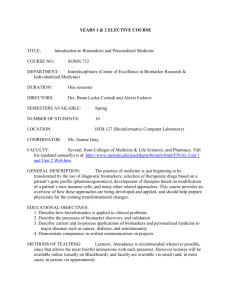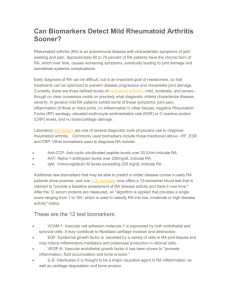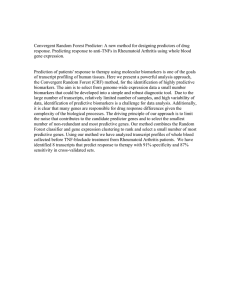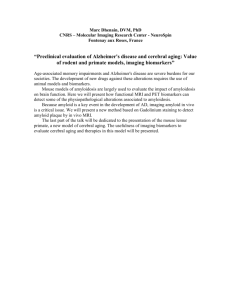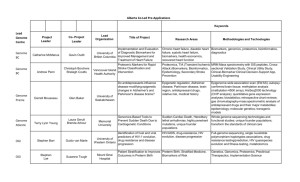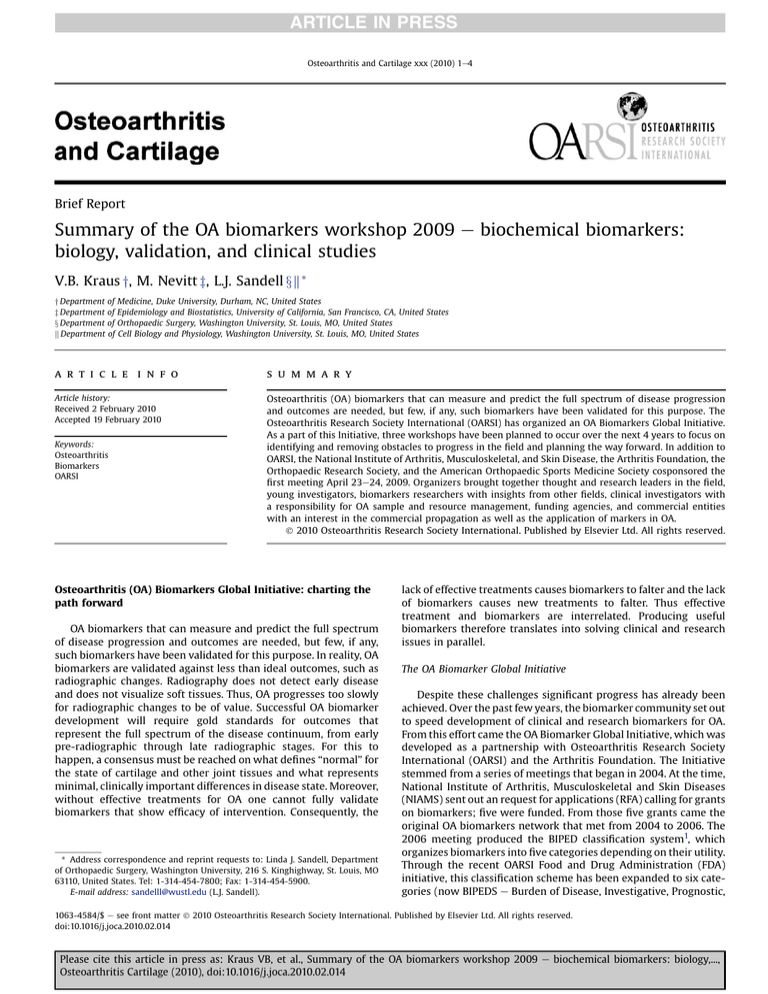
ARTICLE IN PRESS
Osteoarthritis and Cartilage xxx (2010) 1e4
Brief Report
Summary of the OA biomarkers workshop 2009 e biochemical biomarkers:
biology, validation, and clinical studies
V.B. Kraus y, M. Nevitt z, L.J. Sandell xk *
y Department of Medicine, Duke University, Durham, NC, United States
z Department of Epidemiology and Biostatistics, University of California, San Francisco, CA, United States
x Department of Orthopaedic Surgery, Washington University, St. Louis, MO, United States
k Department of Cell Biology and Physiology, Washington University, St. Louis, MO, United States
a r t i c l e i n f o
s u m m a r y
Article history:
Received 2 February 2010
Accepted 19 February 2010
Osteoarthritis (OA) biomarkers that can measure and predict the full spectrum of disease progression
and outcomes are needed, but few, if any, such biomarkers have been validated for this purpose. The
Osteoarthritis Research Society International (OARSI) has organized an OA Biomarkers Global Initiative.
As a part of this Initiative, three workshops have been planned to occur over the next 4 years to focus on
identifying and removing obstacles to progress in the field and planning the way forward. In addition to
OARSI, the National Institute of Arthritis, Musculoskeletal, and Skin Disease, the Arthritis Foundation, the
Orthopaedic Research Society, and the American Orthopaedic Sports Medicine Society cosponsored the
first meeting April 23e24, 2009. Organizers brought together thought and research leaders in the field,
young investigators, biomarkers researchers with insights from other fields, clinical investigators with
a responsibility for OA sample and resource management, funding agencies, and commercial entities
with an interest in the commercial propagation as well as the application of markers in OA.
Ó 2010 Osteoarthritis Research Society International. Published by Elsevier Ltd. All rights reserved.
Keywords:
Osteoarthritis
Biomarkers
OARSI
Osteoarthritis (OA) Biomarkers Global Initiative: charting the
path forward
OA biomarkers that can measure and predict the full spectrum
of disease progression and outcomes are needed, but few, if any,
such biomarkers have been validated for this purpose. In reality, OA
biomarkers are validated against less than ideal outcomes, such as
radiographic changes. Radiography does not detect early disease
and does not visualize soft tissues. Thus, OA progresses too slowly
for radiographic changes to be of value. Successful OA biomarker
development will require gold standards for outcomes that
represent the full spectrum of the disease continuum, from early
pre-radiographic through late radiographic stages. For this to
happen, a consensus must be reached on what defines “normal” for
the state of cartilage and other joint tissues and what represents
minimal, clinically important differences in disease state. Moreover,
without effective treatments for OA one cannot fully validate
biomarkers that show efficacy of intervention. Consequently, the
* Address correspondence and reprint requests to: Linda J. Sandell, Department
of Orthopaedic Surgery, Washington University, 216 S. Kinghighway, St. Louis, MO
63110, United States. Tel: 1-314-454-7800; Fax: 1-314-454-5900.
E-mail address: sandelll@wustl.edu (L.J. Sandell).
lack of effective treatments causes biomarkers to falter and the lack
of biomarkers causes new treatments to falter. Thus effective
treatment and biomarkers are interrelated. Producing useful
biomarkers therefore translates into solving clinical and research
issues in parallel.
The OA Biomarker Global Initiative
Despite these challenges significant progress has already been
achieved. Over the past few years, the biomarker community set out
to speed development of clinical and research biomarkers for OA.
From this effort came the OA Biomarker Global Initiative, which was
developed as a partnership with Osteoarthritis Research Society
International (OARSI) and the Arthritis Foundation. The Initiative
stemmed from a series of meetings that began in 2004. At the time,
National Institute of Arthritis, Musculoskeletal and Skin Diseases
(NIAMS) sent out an request for applications (RFA) calling for grants
on biomarkers; five were funded. From those five grants came the
original OA biomarkers network that met from 2004 to 2006. The
2006 meeting produced the BIPED classification system1, which
organizes biomarkers into five categories depending on their utility.
Through the recent OARSI Food and Drug Administration (FDA)
initiative, this classification scheme has been expanded to six categories (now BIPEDS e Burden of Disease, Investigative, Prognostic,
1063-4584/$ e see front matter Ó 2010 Osteoarthritis Research Society International. Published by Elsevier Ltd. All rights reserved.
doi:10.1016/j.joca.2010.02.014
Please cite this article in press as: Kraus VB, et al., Summary of the OA biomarkers workshop 2009 e biochemical biomarkers: biology,...,
Osteoarthritis Cartilage (2010), doi:10.1016/j.joca.2010.02.014
ARTICLE IN PRESS
2
V.B. Kraus et al. / Osteoarthritis and Cartilage xxx (2010) 1e4
Efficacy of Intervention and Diagnosis of the Disease and Safety of
interventions) to include the concept of safety biomarkers.
To extend the success of earlier meetings, the Initiative held an
organizational meeting in Rome in 2008 [http://www.oarsi.org/
meetings/08Congress/index.cfm], where participants defined the
state-of art in OA-related biomarkers.a
In 2009, NIAMS provided the OA Biomarker Global Initiative
with funding for three additional workshops: The Initiative will
apply this funding towards a series of workshops that address
different aspects of OA biomarker development. The meetings are
designed to encourage international participation on a selection of
topics related to OA biomarkers. The workshops will also build on
the structure and connections already established through the
National Institutes of Health (NIH)-sponsored OA biomarker
network. This arrangement addresses the needs of young investigators; establishes a structured network to advance the OA-related
biomarkers field; explores funding possibilities to support work in
this area; and interacts with the FDA to assist in development of
guidelines related to the use of biomarkers in clinical trials.
The first of three NIAMS-funded meetings was held from April 23
to 24, 2009 [http://www.oarsi.org/index2.cfm?section¼Meetings_
Events&content¼OABiomarker]. In addition to OARSI, the NIAMS,
the Arthritis Foundation, the Orthopaedic Research Society, and the
American Orthopaedic Sports Medicine Society cosponsored the
2009 meeting. Organizers brought together thought and research
leaders in the field, young investigators, biomarkers researchers with
insights from other fields, clinical investigators with a responsibility
for OA sample and resource management, funding agencies, and
commercial entities with an interest in the commercial propagation
as well as the application of markers in OA; 125 people attended.
Leading the path forward
Biomarkers are considered transformative technologies because
they join the trend towards wellness in healthcare, companion
diagnostics, and the focus on prevention. However, any conversation
meant to bring OA biomarkers forward should carry a reminder of
how much biomarkers could help the arthritis community. From an
economic point of view, biomarkers that distinguish early OA could
significantly lower healthcare costs for treatment and detection.
As envisaged by the BIPEDS classification scheme, biomarkers can
advance knowledge of OA by providing information on B urden of
disease, P rognosis of disease, E fficacy of interventions, Diagnosis of
disease, S afety of interventions, and its pathophysiology, (all categories plus I nvestigative). Specifically, biomarkers could possibly
detect OA before potentially irreversible changes in structure or
function occur and thus allow intervention at an early stage; they
could predict which patients will progress to joint damage and how
quickly such progression occurs. Biomarkers should thus be applicable for research in large patient cohorts and animal models. Such
biomarkers could make clinical trials less costly and more efficient
and give an earlier indication in phase II trials of whether interventions are working. To date, no OA-related biomarker has yet undergone the formal approval process by the Federal Drug Administration
to be considered a qualifying endpoint for a phase III clinical trial.
Clinical validity
In the near future, there is a great likelihood that biomarkers will
contribute increasingly to drug development. Drug developers are
eager to use biomarkers to improve safety, efficacy, and to optimize
drug dosing. Patients are eager to use predictive medicine tests to
improve health and choice of appropriate drugs for more personalized and appropriate treatment. However, as noted by Dr. David
Johnston, (LabCorp), at the Global Initiative’s first workshop, OA
biomarkers need to provide actionable test results before such
information can impact medical practice. OA biomarkers could
achieve clinical utility in a variety of settings. For instance, OA
biomarkers could support effective pharmacological treatment or
provide screening tools. These observations further underscore the
interrelatedness of biomarkers and development of effective treatments that constitute the action triggered by the diagnostic test.
Clinical validity for OA biomarkers has been elusive in part
because of the dearth of sensitive gold standards for biomarker
qualification and because of current limits of technical validation.
Radiography provides the foundation for OA diagnosis and treatment but pre-clinical OA can’t be detected by X-ray. Biomarkers
could detect early disease but would benefit from an imaging
modality that provides a better measure against which they can be
qualified. In turn the qualification of biomarkers (non-imaging and
imaging) need to be anchored to patient-relevant clinical endpoints.
Thus, the biomarker community recognizes that advances and
qualification of non-imaging biomarkers and advances and qualification of imaging biomarkers are inextricably linked. Both will be
important components of an integrative diagnostics toolbox for OA.
Technical validation presents challenges because the tissue source
of biochemical biomarkers can reflect body-wide changes in collagen
degradation. In her opening remarks at the Global Initiative’s first
workshop, Virginia Byers-Kraus noted that collagen fragments
measured in the serum or urine probably reflect activity in many tissues
over the whole body (including other joints, bone and intervertebral
discs), not just in the affected joint chosen for imaging. The wide, dayto-day variation in many biomarkers also complicates identification of
early OA changes through assessment of systemic levels of a biomarker.
The Global Initiative plans to address these challenges.
Redefining normal
At a more fundamental level, questions remain about the definition of OA as a disease at the level of individual tissues. In
particular, the normal state of cartilage has not been well defined.
Without knowing what is “normal” for cartilage turnover with age,
as reflected by biomarkers in body fluids, it is difficult to distinguish
with assurance the presence of disease and the extent or burden.
Therefore, advancement of biomarkers to fully define disease
burden and classify the disease into subtypes, or “phenotypes”, will
rely on further characterization and understanding of normal
cartilage turnover. In clinical trials, biomarkers increase the variance in total body burden of disease explained over simple
demographic factors. Robust correlation between total body
burden and several biomarkers could be revealed by adequate
patient phenotyping by either X-ray or other imaging modalities.
Our current measure of disease presence e X-ray e is crude and
insensitive i.e., X-ray may be normal but cartilage is not. Therefore, the
measure of total body disease burden based on X-ray is also crude and
insensitive. More sensitive measures of disease burden will enhance
biomarker evaluation and we are beginning to see technologies that
would provide better measures, such as MRI to measure cartilage and
meniscal changes, Delayed Gadolinium-Enhanced MRI of Cartilage
(dGEMRIC) with MRI to measure proteoglycan changes, and bone
scintography to measure changes in bone.
Filling the biomarker toolbox
a
Materials related to the OA Biomarkers Global Initiative meetings in Rome and
Washington DC are available on the OARSI.org website.
Any biomarker toolbox will likely combine imaging technology
such as MRI with several biochemical markers. Several types of
Please cite this article in press as: Kraus VB, et al., Summary of the OA biomarkers workshop 2009 e biochemical biomarkers: biology,...,
Osteoarthritis Cartilage (2010), doi:10.1016/j.joca.2010.02.014
ARTICLE IN PRESS
V.B. Kraus et al. / Osteoarthritis and Cartilage xxx (2010) 1e4
3
Fig. 1. OA is typically a slow, insidious and debilitating process that, like other prominent chronic diseases, is likely more amenable to remission early in the disease process. With
a renewed focus on acute joint injury and the prevalence of severe consequences, the concept that “Joint infarction like myocardial infarction requires acute intervention” is
conveyed to foster debate, discussion, and research, in order to discover new treatment paradigms to make a lasting difference in outcomes.
biomarkers will be necessary to make this happen and they’ll likely
be a combination of prognostic, and efficacy of intervention
markers. The goal is to develop a toolbox of markers that engender
trust and reliance. The OA Biomarker Global Initiative discussed
plans to tailor biomarker research and development towards
creating a warehouse of molecular markers that can individually, or
in combination, discriminate stages of OA, structure, function, or
pain, and predict outcomes in each of these areas.
One disease model that already uses biomarkers in a combinatorial manner is cancer. The Initiative could adopt, at least in part,
the model of the Early Detection Research Network For Cancer
(EDRN), which aims to use biomarkers for early cancer detection.
EDRN uses a large collaborative engine to fuel biomarker discovery
by forging a link among laboratory research and academic, clinical,
and industrial leaders. Although this network is much larger than
would likely be needed, or feasible, for OA the structure in terms of
data and management and coordination could be emulated.
A new image of OA
Perhaps the most critical step forward involves perception
rather than science or data management. The way OA is viewed at
every level needs to be changed at the outset. One can argue that
biomarker development has been stalled, in part, because OA is not
widely understood and its impact as a chronic disease with a long
“silent” period is not fully appreciated. If healthcare professionals
and medical consumers learn to see OA in the same terms they
view other ‘more threatening’ chronic diseases, a completely
different picture of OA emerges (Fig. 1). Just as a heart attack or
stroke can represent the end stages of long-simmering cardiovascular disease, radiographic joint space narrowing shows a joint in
failure that began failing perhaps decades earlier2. What we call OA
is the outcome of a long, often silent disease process.
Another useful change in the way we view OA would be to
recognize the heterogeneous nature of the disease and focus more
on specific disease subsets. In the past, for example, clinical trials
have enrolled a heterogeneous population, even testing a treatment of OA in a specific joint. For example, treatment trials typically
enroll a sample around age 60 with a painful knee or hip. Such trials
have often been inconclusive and this may be due a population that
is too heterogeneous in risk of progression and includes too few
joints that progress during the study for adequate power in evaluating success. Designing clinical trials so they start with a more
homogenous and rapid progressor population could bring more
definitive outcomes. To do this requires a better ability to identify
subtypes of OA that progress at different rates.
OA is the common endstage of a variety of inciting causes
including genetics, joint trauma, and metabolic disturbances, to
name a few. Subtle differences in the manifestations of OA arise as
a result of the different inciting etiologies. Medically, these differences result in different phenotypes or subtypes of OA that vary by
joint site, primary compartment of involvement, primary radiographic features, and localized vs generalized disease, to name of
few of the differences. However, to date, most biomarker clinical
research has focused on relatively late-stage knee or hip OA.
Much discussion at the Global Initiative’s first workshop hinged
on finding a way to model early-stage OA. Stefan Lohmander and
others proposed studying OA via the post-traumatic injury disease
model. Acute injury provides a clear starting point for joint
degeneration because the time of the injury is known. The disease
may also follow a shorter time course because onset is likely to
occur over a shorter time period compared to following a cohort
with risk factors other than injury. In teens or early twenties the
injury population may show early elevation of some biomarkers.
This approach might uncover a whole different set of markers for
pre-symptomatic OA than there is for cartilage degeneration later
on. Good animal injury models are already in place. Therefore,
a post-traumatic injury model could be used to complete the
picture of disease progression from beginning to end. Potentially,
biomarkers might be the best way to begin to monitor the beginnings of post-traumatic OA because it’s known that a high
percentage of people with joint injury (~50%) will progress to latestage disease.
Optimize existing samples
Many blood and urine samples from clinical and epidemiological studies with high quality clinical and structural outcome data
already exist in labs worldwide. The Global Initiative is providing
information about existing resources and ways to access and use
Table I
OA Biomarker Global Initiative Broad Goals
Increase awareness of OA as a disease with a long silent period that leads to joint
failure in a large percent of those affected
Define and develop a paradigm of molecular, pre-radiographic
and radiographic OA
Identify subgroups, e.g., early OA and post-injury OA, etc
Influence/channel research to advance biomarker development
Optimize use of existing sample and clinical study resources
Develop partnerships with the NIH, industry and service organizations
Please cite this article in press as: Kraus VB, et al., Summary of the OA biomarkers workshop 2009 e biochemical biomarkers: biology,...,
Osteoarthritis Cartilage (2010), doi:10.1016/j.joca.2010.02.014
ARTICLE IN PRESS
4
V.B. Kraus et al. / Osteoarthritis and Cartilage xxx (2010) 1e4
Table II
April 2009 way forward
Develop consensus on a standard clinical outcomes
Develop guidelines for OA biomarker validation and qualification
Explore using a post-injury model as the pathway to progress
Support future development of biomarkers, biomarker methodologies and
clinical studies
Provide guidelines for sample collection in biomarker and clinical studies
Identify independent labs to run assays
Join forces with imaging biomarker efforts
Develop a proposal to evaluate a panel of biomarkers in the Osteoarthritis
Initiative (OAI)
Establish a plan to evaluate panels of markers in existing clinical trial samples
these sample and clinical study resources for development and
qualification of a variety of prognostic and predictive biomarkers.
Important questions for users to consider in using such specimens
for biomarker development include:
Is the specimen the right type and the quantity adequate?
What are the likely impacts of not meeting sample
requirements?
Can effects of uncontrolled factors (time of day, diseases,
medications, food intake, etc) be controlled by subject selection
or in analysis?
Are techniques for collection and handling similar to conditions under which the assay was validated?
If validation conditions are not met, can limitations be
overcome?
The first workshop of the OA Biomarker Global Initiative took
some solid steps along that path. The group set both long and
short-term goals to advance the stage of biomarker qualification
(Tables I and II). The atmosphere was one of inclusiveness and
cooperation. Participants discussed the path forward through
biology, validation, clinical studies, and creation of new paradigms.
Over the long-term, the Initiative aims to improve the lives of
arthritis sufferers.
Author contributions
Linda J. Sandell, Organizer and Co-Chair of Meeting.
Virginia Byers-Kraus, Co-Chair of Meeting.
Michael Nevitt, Co-Chair of Meeting.
All authors participated in writing and editing the Meeting Report.
Conflict of interest
Dr. Sandell receives royalties from Millipore.
Acknowledgements
The authors wish to thank science writer Jeanne Erdmann for
help in preparation of this manuscript. Ms Erdmann was supported
by general funds for the meeting. The meeting was funded by the
National Institute of Arthritis, Musculoskeletal and Skin Diseases,
the Arthritis Foundation, OARSI, American Orthopaedic Society
for Sports Medicine, the Orthopaedic Research Society, Amgen,
Immuno Diagnostic Systems, Synarc and Wyeth.
Role of funding sources in the publication: None.
A new approach
References
An organized network of biomarker enthusiasts can most
effectively answer these questions, as well as address pertinent
issues, such as changing the way people view OA. This effort could
begin, as Kraus describes, by finding ways to release the logjam in
drug development and finding a model that scientists can follow.
Post-traumatic OA offers one way to acutely release the logjam.
1. Bauer DC, Hunter DJ, Abramson SB, Attur M, Corr M, Felson D,
et al. Classification of osteoarthritis biomarkers: a proposed
approach. Osteoarthritis Cartilage 2006;14:723e7.
2. Kraus V. Waiting for action on the osteoarthritis front. Curr Drug
Targets 2010;11(4):1e2.
Please cite this article in press as: Kraus VB, et al., Summary of the OA biomarkers workshop 2009 e biochemical biomarkers: biology,...,
Osteoarthritis Cartilage (2010), doi:10.1016/j.joca.2010.02.014

